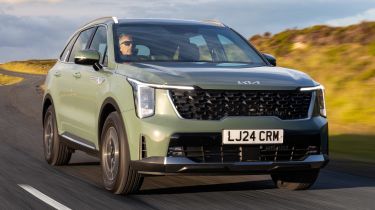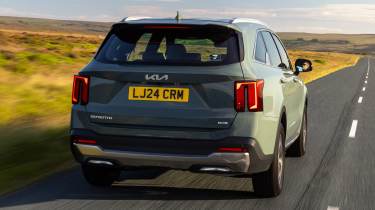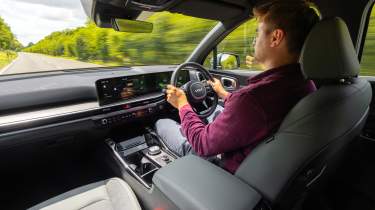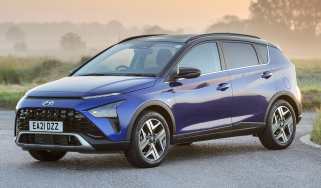New Kia Sorento Hybrid 2024 review: family favourite SUV ups its game
The popular seven-seat Kia Sorento SUV gets a new look, and a lower starting price

Verdict
Well-equipped, spacious and comfortable, the Kia Sorento remains a top contender in the seven-seat SUV segment. A wider choice of engines and trim levels make it more appealing than ever - as does the lower list price. A slightly dull drive is the only real negative here.
At the top of Kia’s internal-combustion engine range sits the seven-seat Sorento SUV - which has just received a mid-life facelift for 2024. The pre-facelift model was one of our favourite family SUVs, partly thanks to the breadth of choice in its range with self-charging hybrid, diesel and plug-in hybrid power offered. The trim level choice shrunk towards the end of the pre-facelift car’s life to just the one ‘Edition’ trim but thankfully Kia has now expanded the Sorento lineup to nine different configurations with ‘2’, ‘3’ and ‘4’ trim levels offered on each of the three powertrains.
So a good start for the Kia Sorento then. We’ve driven the facelifted Sorento before in the US, but that was mainly to get a taste for its updated exterior looks and new interior dash layout because the 2.5-litre turbocharged petrol engine in that car won’t be offered over here in the UK. Kia says the 1.6-litre, turbocharged four-cylinder self-charging hybrid will be the most popular iteration with UK customers and that’s what we’re driving here.
Used - available now

2022 KIA
Sorento
51,703 milesAutomaticPetrol1.6L
Cash £27,763
2022 KIA
Sorento
24,049 milesAutomaticPetrol1.6L
Cash £30,700
2019 KIA
Sorento
37,516 milesAutomaticDiesel2.2L
Cash £23,815
2019 KIA
Sorento
48,518 milesManualDiesel2.2L
Cash £16,997Starting with the exterior changes, Kia claims these “embody futuristic boldness for a more premium look” - the design certainly takes inspiration from the new all-electric EV9 with Kia’s new ‘star map’ headlight shape and a repositioning of the badge to the bonnet. There’s a new interpretation of Kia’s ‘tiger nose’ grille at the front, animated indicators and a selection of new 17-inch alloy wheels on the hybrid and diesel models, with the PHEVs gaining 19-inch wheels (‘3’ trim gets 19s as standard on all models with ‘4’ bringing 20-inch rims).
There are more changes to the rear with a new LED rear light design and a redesigned bumper with a wide skid plate to give the Sorento a more off-road inspired look. Those tough looks are backed up by all-wheel drive being made standard on all versions of the Sorento and this also comes with Kia’s ‘Terrain Mode’ system - allowing drivers to choose from ‘mud’, ‘snow’ and ‘sand’ modes. With no locking differential the Sorento won’t trouble a Land Rover Defender for off-road prowess, but we found it perfectly able to tackle some fairly grubby forest tracks.
As for on the road, the Sorento drives pretty much the same as before. The self-charging hybrid utilises a relatively small 1.49kWh battery located under the front seat and sends power to an electric motor which can drive the Sorento by itself at low speeds - Kia doesn’t quote a speed at which the petrol engine takes over but we got the EV-only mode to run up to 33mph on our test. With 86bhp, the electric motor is pretty keen at low speeds, too.
The total power output between the electric motor and the 1.6-litre petrol engine is 212bhp with a torque figure of 367Nm. Even with a relatively modest kerbweight for a seven-seat SUV of 1,959kg, the Sorento Hybrid doesn’t feel all that punchy - something that isn’t helped by the slightly sluggish six-speed automatic transmission (the gearshift paddles behind the wheel don’t liven things up either). It’s not slow though, there’s enough electrical torque to aid in-gear responsiveness and power is delivered smoothly - our car didn’t have all seven-seats occupied, however, and a full load would certainly dent performance.
The Kia Sorento is sensibly set up for ride quality over driver engagement. Our car’s 17-inch wheels looked almost comically small and while the massively profiled tyres no doubt helped absorb bumps in the road, we felt no downturn in comfort when we tried the 19-inch wheels. The steering feels nicely weighted in the Sorento and road-holding is generally adequate for a large SUV, but there’s a bit of a delay in the front end responding to steering inputs which seemed mainly due to the incredibly soft front damping. Despite being a seven-seater, the Sorento doesn’t feel unwieldy on tight British backroads either.
There’s very little road and wind noise that seeps into the cabin of the Sorento and on the whole, refinement is impressive. It is noticeable when the petrol engine fires into life after the serenity of having electric-only power, but the transition feels smooth enough.
Something Kia managed to engineer into the Sorento well was the ease of access to the third-row of seats. It’s simple to slide or recline the middle row, which has 60:40 split folding functionality. Tall adults can make use of those rearmost seats, even with another tall adult occupying the middle row in front. The caveat is that this is better only for relatively short journeys because the high floor means your legs are quite bunched, kids will have no problem back there, though.
Up front the Sorento has been given Kia’s latest dash layout, seen in the EV6 and EV9. The old physical switches and dials for the climate control and radio have gone with a familiar strip of touch-sensitive buttons. Don’t worry though, these are among the best touch-sensitive controls out there as they’re responsive and labelled clearly.
On top of the dash there’s a new dual screen setup comprising two 12.3-inch screens. Wireless Android Auto and Apple CarPlay come as standard, which is just as well because while Kia’s infotainment is perfectly fine - the sat-nav screen isn’t the easiest to read on the move with its black background.
Equipment has always been a strong suit of the Kia Sorento and this facelift has introduced a few neat touches. The overall quality of materials in the cabin has been overhauled with an eye on sustainability with more artificial leather and recycled cloth. It certainly feels classy in there but, crucially for a family SUV, well-built as well.
At £41,995 for the entry-level ‘2’ model in diesel guise, the Sorento is £3,030 cheaper than the run-out ‘Edition’ of the pre-facelift. Still, you won’t feel short changed in the ‘2’ - which gets heated front seats, rain-sensing wipers, six USB-C charge ports and a reversing camera. The ‘3’ starts at £46,195 and for that you get 19-inch alloy wheels, tinted windows, a 360-degree camera, black leather seats, a wireless smartphone charger, self-levelling rear suspension and an uprated sound system.
The ‘4’ - the trim level Kia says will be the most popular - starts at £50,695, but you get a panoramic sunroof, black Nappa leather seats with ventilation and memory function and a digital rear view mirror. The ‘4’ also introduced several new features as part of the facelift including fingerprint recognition for security, a customisable head-up display and ambient lighting.
| Model: | Kia Sorento Hybrid '2' |
| Price: | £42,995 |
| Powertrain: | 1.6-litre petrol turbocharged four-cylinder + electric motor |
| Transmission: | Six-speed automatic |
| Power/torque: | 212bhp/367Nm |
| 0-62mph: | 9.7 seconds |
| Top speed: | 113mph |
| Economy/efficiency: | 42.2mpg/153g/km |
| Size (L/H/W): | 4815mm/1695mm/1900mm |
| On sale: | Now |












